People often ask me what food companies and brands I recommend.
I tend to like companies that are transparent and support farms of all shapes and sizes. (Transparency is so important in the farming world and food supply nowadays, isn’t it?) I love science-based brands that don’t use misleading marketing (like how non-GMO is too often used), and I love supporting small neighborhood family farmers. I like quality food that just tastes good!
I guess that’s why I have to give a shout out to Prairie Farms Dairy! I go out of my way to purchase their dairy products, particularly because they do such a great job promoting and supporting small family farms like our family, friends, and neighbors.
Meet Mrs. Thompson. This would be my boyfriend’s aunt and also our neighbor. They have a dairy herd of only 30 cows — which is very small by today’s standards! It’s great to see Prairie Farms get their milk from small farmers right in my community, where it gets turned into cheese only a couple of miles away here in northeast Iowa.
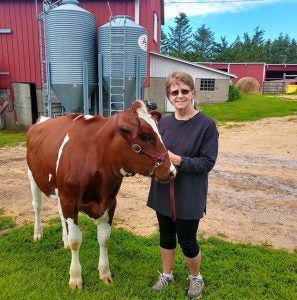
After we visited their family farm, Prairie Farms took me on a tour of the local cheese plant to learn more about where the milk goes and how they make delicious cheese!
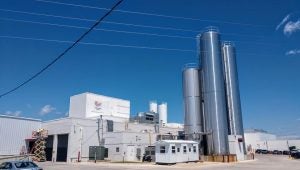
Here the milk from well-kept cows raised by our friends and family gets unloaded and stored in silos. One of the larger silos can hold 515,000 pounds of milk! It takes approximately 100 pounds of milk to make 8.8 pounds of cheese depending on the type of cheese and the season. For example, if it’s really hot out, milk tends to be a little more watered down since the cows drink more water, so it may require more milk to make the cheese.
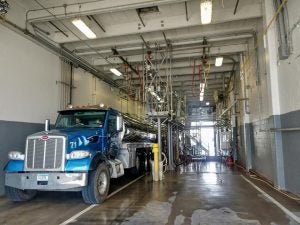
Next, the milk is cleaned and pasteurized and put into cheese vats, where they add water, rennet, cultures, etc. This is the make step where milk becomes cheese and turns into curds and whey. They start by making 200-pound blocks of cheese, where they’re then cut down later into the proper sizes.
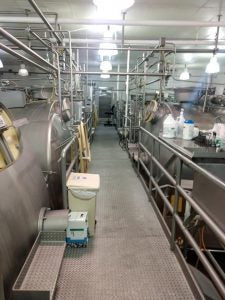
Next are press tunnels, fermentation rooms, and brine. At this cheese plant, they underwent a $21 million expansion a few years ago, where they make their award-winning cream cheese, such as Swiss and cheddar, that goes all over the world! The photo below is of huge blocks of cheese floating in a green brine. I must admit I was a little concerned about the green color! People generally want the least amount of chemicals in their food, but the green color is really just salt. That’s it! Salt makes the water turn green and it is supposed to be almost a “Mountain Dew color” green. Green brine is clean brine! But that’s where they get some of that salty cheese flavor and longer shelf life.
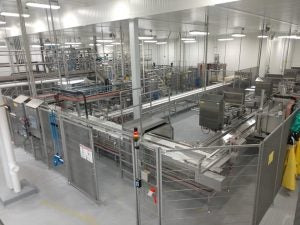
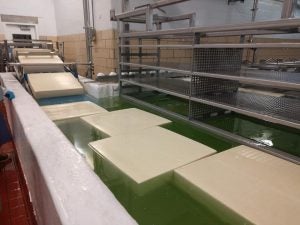
After this, cheese is cut, packaged, inspected, tested, stored and shipped. It really is an extensive, impressive process! We also watched how they package their cream cheese, where Sarah, their Dairy Ingredients manager, shows off the finished product.
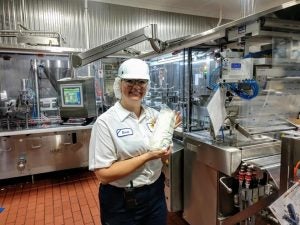
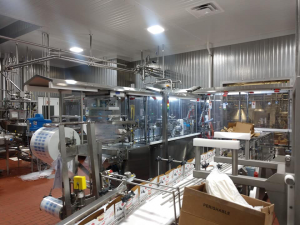
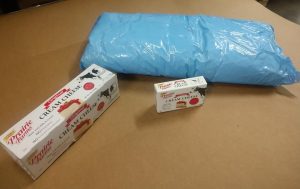
Here they make cream cheese from 8-ounce servings up to 25-pound bags, whether it’s small personal sized or larger commercial scale for restaurants and bakers. (The product is amazing for cheesecakes!)
And speaking of ingredients, their cream cheese is made of pasteurized milk and cream, salt, cheese cultures, and carb bean, which is a stabilizer. The salt also gives it a longer shelf life, where the product is packaged with minimum air to maintain freshness and quality.
To be called a certain type of cheese, it must have a certain percentage of fat, moisture, and protein, among other things, as a standard of identity. Cheeses are also randomly pulled off the assembly line several times an hour for in-house testing and to check production and seals to make sure everything is working well, since they make up to 9,000 pounds of cheese per hour! In one day, this cheese plant goes through approximately 1,200,000 pounds of cream and milk per day (about one milking for 30,000 cows) and employs 130 people or so in my community.
The production facility also goes thorough cleaning and dozens of audits per month, both internally and externally. I find food science and testing so interesting!
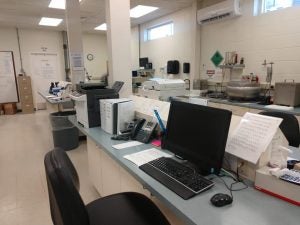
Consumers want transparency in the food supply, and I applaud Prairie Farms Dairy for showing me what they do so I can pass this information along to you all! It’s definitely one of my favorite brands of dairy since they support small local family farms, don’t use a lot of misleading marketing labels, and open their doors to show what happens within their company.
For more info you can check out their website and the hashtag #JoinOurMoovement. Thanks Prairie Farms!
Michelle Miller, the Farm Babe, is an Iowa-based farmer, public speaker, and writer, who lives and works with her boyfriend on their farm, which consists of row crops, beef cattle, and sheep. She believes education is key in bridging the gap between farmers and consumers.



